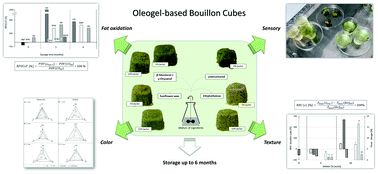Improving the nutritional profile of culinary products: oleogel-based bouillon cubes
Abstract
Structured fat phases are the basis of many consumer relevant properties of fat-containing foods. To realise a nutritional improvement – less saturated, more unsaturated fatty acids – edible oleogels could be remedy. The feasibility of traditional fat phases structured by oleogel in culinary products has been evaluated in this study. In this contribution the oleogel application in bouillon cubes as model system for culinary products is discussed. Three different gelators (sunflower wax (SFW), a mixture of β-Sitosterol and γ-Oryzanol (SO) and ethylcellulose (EC)), at two concentration levels (5% and 10% (w/w)) each, were evaluated with respect to their physical properties, in the food matrix and application. The application of pure and structured canola oil (CO) was benchmarked against the reference, palm fat (PO). The assessment of the prototypes covered attempts to correlate the physicochemical analyses and sensory data. Organoleptic and analytical studies covered storage stability (up to 6 months) monitoring texture, color and fat oxidation. The results indicate that the substitution of palm fat by oleogel is essentially possible. The characteristics of the bouillon cubes are tuneable by gelator choice and inclusion level. Most importantly, the data show that the anticipated risk of intolerable effects of oxidation during shelf life is limited if antioxidants are used.



 Please wait while we load your content...
Please wait while we load your content...